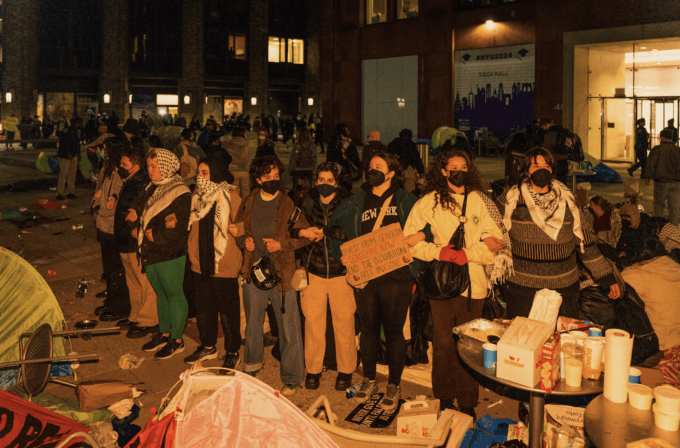College campuses and universities across the country have organized some of the largest peace activities and anti-war protests since 1969. As the social movement points in specific directions in calling for Palestinian liberation, over 100 schools scattered across the United States from American to Yale University have participated and issued their own sets of “Five Demands.”
College students especially are utilizing and expanding their educational experiences and cutting their activist teeth on campus in the form of teach-ins, demonstrations, lectures, speeches, and creative art, largely on their own but also with facilitation and professors in solidarity. Further, it’s not lost on young people elsewhere, as news of the movement reached the Gazan children along with families expressing their gratitude.
A common reaction to the widespread nature and success stories on the part of the student activists has been for naysayers to label and paint the demonstrators and demonstrations as antisemites engaging in antisemitic activity. Perhaps a tool and offshoot from the modern hasbara playbook: Its purpose is to draw suspicion over a real and authentic concern of historical and current antisemitism.
There are several ways critics and campus protest skeptics have constructed their own reality to undermine student resistance. The methods include counter-protesting, the calling of police, message distortion, flimsy polling data, and the utilization of the mainstream press.
From the look of the counter-protesting, the goals look fairly obvious. First, counter-protesting presupposes that the Mideast world was a tidy and peaceful place on October 6th and that Iranian and Lebanese proxies simply created a need for power and dominance to defend “good states” (US, Israel, Saudi Arabia) from “bad states” (Yemen, Iran, Syria) on October 7th. As reported by journalist Joshua Frank, one Columbia professor’s motivation to counter-protest wasn’t based on any intellectual argument at all but rather significant familial ties to arms manufacturing.
Secondly, counter-protesting invites people to think that Israeli force and Palestinian resistance present a “both sides” argument (bad) and this ranges to counter-protesting that characterizes Netanyahu policy as self-defense (worse). Another motivation of counter-protesting is to draw ire and/or elicit a slip up in words or actions from budding activists in a further effort to categorize them as antisemitic.
Hecklers of the encampments have tried to test random students with gotcha questions regarding geography (re: from the Jordan River to the Mediterranean Sea), to sending in staged distractions to enhance the possibility of media spectacle. These techniques haven’t amounted to much but the proposition alone that they are feasible is enough to warrant a concern regarding perhaps the ultimate goal of counter-protesting – to necessitate a presence for law enforcement.
The idea and symbolic presence of law enforcement in the face of the encampment promotes the idea that the cops are there to catch bad people and to ensure that good kids can safely get to class (they always could) when in fact the role of the police hasn’t changed since the days of ancient societies. That is, the main roles of the police are to protect private property and concentrations of wealth and power from well-organized outside forces of resistance. Often, it is the police force’s duty to make sure that mass movements and mobilization techniques are struck down while maintaining a highly stratified society based on law and order. Universities are complicit businesses that must carry on undisturbed just as free enterprise must remain steady.
It does not help the students either that almost all of New York City’s political class, as an example, is tied to the established order and Biden’s bipartisan consensus when it comes to the Israeli-Palestinian conflict. Although they differ from Republicans, Eric Adams and Kathy Hochul are poised to undermine the student’s resistance just as they are to cut public resources whenever their respective donor classes apply economic or political pressure. When a mayor or governor cannot deviate very far from the established order, the police become willing combatants against the students and professors. The misinformation on the part of the police was best illustrated when the NYPD Commissioner held up a copy of Oxford’s Very Short Introduction Series (Terrorism) believing it was a student’s “how to” book. It served as a microcosm for how the entirety of the encampments have been misunderstood by people with authority.
One of the more bizarre aspects of the politics of encampment are how the detractors purposefully change the meaning of protest rhetoric as a scare tactic. In response, it reached a level of such carelessness that a Peace Action Group in New York went out of its way to prohibit signs, slogans, and chants at one of their pro-Palestine rallies. They feared that saying such words as “decolonize,” “intifada,” and “revolution,” (even when Jewish activists wanted to use these words) all constituted terms beyond their control. This form of liberal respectability unfortunately played into the hands of the forces attempting to “other” the campus protests. This wasn’t liberal rationality to eliminate infantile leftism as a knee jerk reaction, but servility to power and privilege to protect their organization.
It gets worse. In a recent Hillel Poll, it found that 61% of college students surveyed cited antisemitism on campus in the wave of protests and encampments. If that wasn’t bad enough, they also concluded that intimidation and assault were increasing because of the protests, while disrupting the ability to attend class (as if student engagement is not a part of higher educations’ purpose). Sociologist Eman Abdelhadi has documented the dialogue and mutual respect found in the encampments that counters Hillel’s forms of crooked data that frames hand selected polls to intentionally distort specific points of view.
Although Hillel’s polling might be more of a political reaction to the reality that many campus demonstrators are in fact Jewish, and not antisemites, it nonetheless sounds convincing, especially when you do not wish to deny a student’s experience or feelings on the matter.
International relations scholar Richard Falk indicated to me that Hillel polls are suspect for a variety of reasons. First, the polls serve as ways to discourage activism that a strong majority of Hillel students may have previously opposed on its merits. Second, facts get in the way of the polls. 15 of 17 ICJ judges (of the two dissenters, one was the ad hoc Israel judge, the other a juridically deviant Ugandan judge with poor prior reputation) have views aligned with the student protests, and not the government.
And on an urgent issue of genocide, they support the right of protest. Falk posited further, “Would we accept a comparable argument that anti-Nazi protests in the late 1930s should be suspended because they made German students uncomfortable? Would anyone dare make such an argument?” “Deconstructing the polls is an important issue,” Falk asserted, “given their manipulative role in the present context as justification for encroaching upon the core role of academic freedom in a democratic society.” Middle East historian Lawrence Davidson stated that historically, white students said similar things when schools attempted integration.
Professor and author Stephen Zunes explained to me that Hillel potentially reaches out to students that reinforce their organizational mission. Since Hillel has moved to the right over the last ten years or so, “[they are] essentially saying non-Zionist Jewish students are unwelcomed.” He continued by stating, “even if they did reach out to a more representative sampling, non-Zionist Jewish students might not want to respond if they knew it was from Hillel.” Zunes also pointed out to me: “If [students] are being told repeatedly that ‘River to the Sea’ is not a call for a democratic secular state but the killing/expelling of Israeli Jews and that ‘globalize the intifada’ is not a call for civil resistance but for terrorism against Jews, it would not be surprising that they would say they encountered language that was ‘antisemitic, threatening or derogatory toward Jewish people.’”
Collectively it seems, the goals of the counter-protestors, police, politicians, polls, and corporate media, are to conflate student support for Palestine with the center-right Hamas (who won with less than 50% of the vote in 2006) while categorizing them as a single entity without social, political, economic, or military wings. Perhaps no journalist is more skillful in this enterprise as New York Times reporter Bret Stephens. In his recent “What a ‘Free Palestine’ Actually Means,” he points out that “Israeli settlers have run riot against their Palestinian neighbors,” but cynically asserts it’s all for naught since “under Hamas” there will simply be no democracy for LGBTQ+ people, thanks to college students. He also oversimplifies and cites corrupt Arab leadership to lessen the burden on Western human rights abuses, as his underlying goal in the piece is to delegitimize any view outside of the political center. Stephens further presumes that the student protestors’ only choices are reactionary forms of ethnic nationalism on either side but to avoid the side they don’t know, Palestine. It reads as an unfortunate concoction of patronizing, gaslighting, and victim blaming
In this writing, I looked at the ways in which campus protest skeptics have developed methods to disparage the encampments. To label them, detractors have crafted an alternate reality or, “big lie” to make the students look hateful, unorganized, unknowing, and disruptive, when they have in fact been the exact opposite. On all counts, the students have been effective in carrying out one of the prime educative examples found in many school mission statements – making extensions beyond the classroom – a feature that institutions advertise, but fear happening because it involves young people questioning the legitimacy of authority and the abuses of power
Daniel Falcone is a teacher, journalist, and PhD student in the World History program at St. John’s University in Jamaica, NY as well as a member of the Democratic Socialists of America. He resides in New York City.


